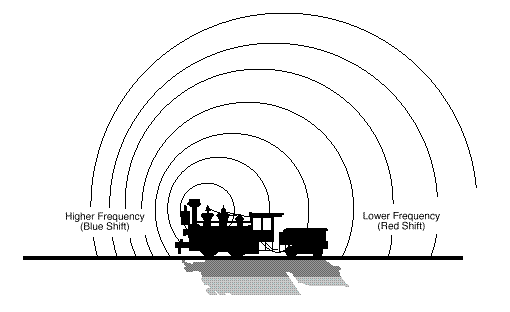
|
Discussion This is a demonstration of the phenomenon called the Doppler effect. It results from the motion of a source (star) relative to the observer and causes its spectra to be shifted toward the red (going away) or toward the blue (coming towards) end of the spectra. Like light, sound travels in waves and there-fore provides an excellent model of the wave behavior of light. The number of waves reaching an observer in one second is called the frequency. For a given speed, frequency depends upon the length of the wave. Long waves have a lower frequency than short waves. As long as the distance between the source of the waves and the observer remains constant, the frequency remains constant. However, if the distance between the observer and the source is increasing, the frequency will decrease. If the distance is decreasing, the frequency will decrease. Imagine that you are at a railroad crossing and a train is approaching. The train is blowing its horn. The sound waves coming from the horn are squeezed closer together |
than they would be if the train were still,
because of the train's movement in your
direction. This squeezing of the waves
increases the number of waves (increases
the frequency) that reach your ear every
second. But after the train's engine passes
the crossing, the frequency diminishes and
the pitch lowers. In effect, the sound waves
are stretched apart by the train's movement
in the opposite direction. As the observer,
you perceive these frequency changes as
changes in the pitch of the sound. The
sound's pitch is higher as the train ap-proaches
and lower as it travels away. The
illustration below provides a graphical repre-sentation
of what happens. A similar situation takes place with stars. If the distance between a star and Earth is increasing, the lines in the absorption or emission spectrum will shift slightly to the lower frequency, red end of the spectrum. If the distance is decreasing, the lines will shift toward the blue end. The amount of that shift can be measured and used to calculate the relative velocity using the following formula. |
